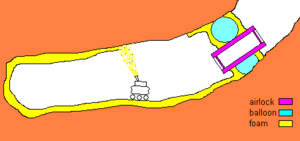Difference between revisions of "Unmanned setup of a whole settlement"
(→Transport of the equipment to Mars: space elevator to reduce costs) |
(→Open issues: soil production experiment) |
||
| Line 38: | Line 38: | ||
==Open issues== | ==Open issues== | ||
| − | *How long does it take to transform regolith to soil? | + | *How long does it take to transform regolith to soil? An [[Experimental setup#soil production|experiment should be carried out]]. |
*Is the automated setup really more expensive? | *Is the automated setup really more expensive? | ||
*How does polyurethane foam act under Martian environmental conditions? | *How does polyurethane foam act under Martian environmental conditions? | ||
Revision as of 05:54, 28 March 2008
The unmanned setup of a whole settlement is a safe, but expensive way to colonize the planet Mars. There are many uncertainties with the alien environment. The equipment is tested on Earth thoroughly, but still the influence of the Martian environment might not be understood completely. The safest way is an unmanned setup by an automated and remote controlled machinery.
Contents
Transport of the equipment to Mars
After evaluation of all known data the location for the initial settlement is determined. The equipment is brought to the Martian surface. This may take several space flights. The equipment for the construction of buildings is brought first.
Since the Martian atmosphere is thin, the landing requires more than just wings. For previous missions additional boosters and parachutes were used. For a colonisation the preceding construction of a space elevator can potentially reduce the costs of landing large amounts of equipment on Mars.
Construction of buildings
Houses, energy-generating appliances and greenhouses are setup and brought into function, all remote controlled from Earth. This habitat must be large enough to provide working space and food production space for an initial population. Probably, this can be done using natural or artificial caves.
Using a natural cave
First the cave is tested for stability with a series of small detonations, forcing loose rocks to fall down. The cave might be shaped a little to remove some prominent noses and to create an even ground.
The entrance is then sealed. The shape of the seal is temporarily supported by means of a balloon, which is sprayed with several layers of polyurethane foam and fiberglass. A pre-processed airlock is integrated with the balloon.
A layer of polyurethane foam is also sprayed upon the entire inner surface of the cave, providing an air-tight and thermal insulating skin.
Now the cave can be filled with soil and air. The bottom is covered with powdered regolith, enriched with fertilizer and moistured with water. An appropriate air pressure is created. A small amount of terrestrial soil implants microbes. Seeds of pioneer plants are brought in to transform regolith into mold, which takes several years. The cave is artificially lit and heated.
Drilling an artificial cave
If no usable natural caves are found an artificial tunnel can be drilled into a rock mountain. The walls of the tunnel must be stabilized. For automated construction the usage of segmented rings can be considered, made from sintered regolith or concrete.
For example, a tunnel with a diameter of 5 meters is drilled. The stabilization reduces the diameter to 4 meters. Thermal insulation leeds to another reduction to approx. 3 meters. With such a tunnel of 1 km length it should be possible to build a greenhouse to feed 10 people.
Greenhouse field trial
From the experiences of Biosphere 2 we can not assume a fully passive stability of the ecosystem. The material of the walls might react with the artificial atmosphere and the substances of the soil, causing a shift in concentration. Also, the hermetic sealing is not perfect. Conclusion: A machinery for automatical control of water, air and soil chemistry as well as pressure control is a must.
When the greenhouses are fully functioning the first plants are brought to Mars. The trial should proof the stability of the biosphere with the metabolism of living plants, decomposition of foliages and reproduction.
Some small animals, such as chickens and rabbits are brought to Mars. They are released in the full-grown forrests of the greenhouses and serve both as a test inhabitant and as a first food source for the settlers.
Arrival of the settlers
The human settlers are shipped to Mars after completion of all construction and evaluation of the tests. After arrival they kill most of the animals and freeze them. From now on the settlers are part of the biosphere. They can rely on a mature and stable habitat.
Open issues
- How long does it take to transform regolith to soil? An experiment should be carried out.
- Is the automated setup really more expensive?
- How does polyurethane foam act under Martian environmental conditions?
- What is the required thickness of foam coating?
| Concepts: | Greenhouse · Settlements · Locations · General |
| Hazards: | Space Weather · Climate · General |
| Technology: | Hi-Tech · Lo-Tech · Energy · Spaceflight science · Communication · General |
| Human Considerations: | Economics · Health · Governance · Trade · Law · Social |








